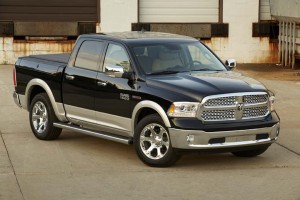
FCA's Ram pickup enjoyed its best March sales total ever. Trucks are more fuel efficient than ever, helping to improve new vehicle fuel economy.
The fuel economy of new vehicles sold in the U.S. continue to improve reaching its best mark ever last month, according to a new report from the University of Michigan Transportation Research Institute (UMTRI), but new car emissions took a step back.
Michael Sivak and Brandon Schoettle, the UMTRI researchers who prepare the report, estimated the average fuel economy of window-sticker values for fuel economy on cars, light trucks, vans and SUVs purchased in March was 25.4 mpg. The figures represented a 0.3-mpg increase from a revised February figure and 5.3 mpg from October 2007, the first full month of monitoring by UMTRI.
However, Sivak and Schoettle issued a monthly update of their national Eco-Driving Index, which estimates the average monthly emissions generated by an individual U.S. driver. The index shifted into reverse and fell back slightly as Americans continued to buy more trucks and utility vehicles.
The EDI edged upward to 0.80 – the lower the value, the better – during January, on the heels of its two best months ever at 0.78 during November and December. The index currently shows that emissions of greenhouse gases per driver of newly purchased vehicles are down 20%, overall, since October 2007. The EDI takes into account both the fuel used per distance driven and the amount of driving – the latter relying on data that are published with a two-month lag.
In a separate study, UMTRI reported that despite U.S. population growth, fuel consumption by American drivers of light-duty vehicles is now lower than it was 15 years ago on the eve of Sept. 11.
In a follow-up to a series of reports released last year, Sivak examined recent trends in fuel consumption by cars, pickup trucks, SUVs and vans in the U.S. fleet from 1984 to 2012.
His findings show that 123.6 billion gallons of gasoline were consumed in 2012 – down 11% from a peak of 138.8 billion gallons in 2004 and less than the 125.9 billion gallons used in 1999.
“The decline of 11% since 2004 reflects the decline in distance driven and the improvement in vehicle fuel economy,” Sivak said.
In addition to total fuel consumption, Sivak examined fuel-consumption rates per person, per licensed driver, per household and per registered vehicle. He found that all four rates were 13% to 18% lower in 2012 than in their peak years of 2003 for registered vehicles, 2004 for the other three measures.
Annual fuel-consumption rates for 2012 were about 394 gallons per person, 584 gallons per licensed driver, 1,021 gallons per household and 529 gallons per registered vehicle.
(BMW reveals all-new M4 convertible. For more, Click Here.)
In addition to examining changes in fuel consumption, the latest study also analyzed changes in the number of vehicles and distance driven.
The corresponding rates per person, per driver and per household each reached their maximum around 2004. Given that the reductions in these rates began to occur several years prior to the onset of the economic downturn that started in 2008, Sivak suggested that the maximum in the rates already reached long-term peaks.
(Click Here to get details on a new vehicle from Kia.)
Although economic factors have likely contributed to declining rates since the economic downturn, other societal changes have influenced the need for personal transportation, such as increased telecommuting, increased use of public transportation, increased urbanization of the population and changes in the age composition of drivers, he said.
(To see if Toyota workers in Canada can join a union, Click Here.)
“The combined evidence from this and the previous studies indicates that – per person, per driver and per household—we now have fewer light-duty vehicles, we drive each of them less and we consume less fuel than in the past,” Sivak said.
Data on international trade collected by the federal government reflects the same trends. As Americans use less fuel, the amount of fuel imported into the U.S. has begun to fall for the first time in decades even while the U.S. economy is growing. While trade is consider critical for economic growth and development, the decline in oil imports leaves more cash in the pockets of ordinary Americans.
